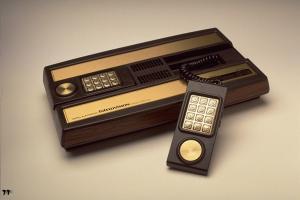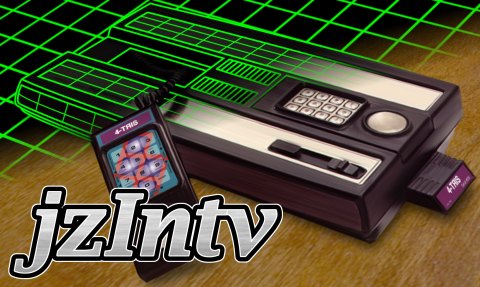There are lots of Intellivision sites out there. But what I’m going to do here is attempt to review Intellivision games from the perspective of playing them via emulation on an arcade cabinet.
My home made arcade cabinet (the Frinkiac 7) runs several emulators. It plays arcade games (via MAME) as well as some home console games. My favorite console system by far is the Intellivision. My brother and I had this system while all our friends had Atari. My father made the choice for us based on the superior graphics that it boasted. I think he regretted it from time to time, because I’m sure my brother and I would sometimes whine that we couldn’t swap cartridges with our friends or that we wished we could play that cool new Atari game. But I’m now glad we had what we had. A lot of the games for Intellivision stand the test of time better than many Atari games did.
Back to the goal of this section of the site. I’m going to address Intellivision games from the perspective of an arcade cabinet owner. I’ll rate the games on a scale of 1 to 5 (1 being poor and 5 being great) based on how well they play on an arcade cabinet. I’ve chosen this scale so that it is compatible with the stuff that’s written up on the intvfunhouse site. If you haven’t checked out that site, you really need to. Steven Orth has done an excellent job documenting and rating most (if not all) of the Intellivision games.
Just take me to the game reviews
The jzintv emulator
For years, I used Joe Fisher’s Nostalgia for playing Intellivision on my arcade cab. However, that emulator is no longer being maintained. That’s not really too big of a deal, but I recently was playing a game in which Nostalgia showed some glitchy graphics. Since that won’t be fixed in the future, I kind of have to move on.
So I’m now using jzintv by Joe Zbiciak. It is a good fit for arcade cabs and other systems that have a front-end running that picks games and runs an emulator accordingly. I believe someone has made a GUI front end for it, but I’ve never tried it. You can get jzintv from Joe’s site at http://spatula-city.org/~im14u2c/intv
Arcade controls
Most cabs are setup for playing MAME. So they usually have some variation on the following:
- 1 or 2 joysticks, with switches mapped to UP, DOWN, LEFT, and RIGHT cursor movement for joystick 1, and R, F, D, G for joystick 2.
- several arcade buttons for player 1, mapped as LCTRL, LALT, SPACE, LSHIFT, Z, X, C, V for buttons 1-8 respectively.
- several arcade buttons for player 2, mapped as A, S, Q, W, I, K, J, L for buttons 1-8 respectively.
- coin buttons for players 1 & 2 (sometimes more), mapped as 5 and 6 respectively.
- player start buttons for players 1 & 2 (sometimes more), mapped as 1 and 2 respectively.
Intellivision controls
An INTV controller has a directional element (the disc), 12 keypad buttons, plus 3 side buttons (the two top buttons are actually the same input).
The directional control can point in 16 directions. That causes just a bit of a problem on some INTV titles, but most can get by with a normal 8-way joystick (some games are actually better with a 4-way).
INTV controllers are wired up in such a way that keypad button presses cannot be processed at the same time that the directional disc is being pressed. This makes certain games like Night Stalker somewhat problematic. Night Stalker uses the numeric keypad as the firing controls. This means that you can’t run and fire the gun at the same time. Fortunately, Night Stalker (and several games like it) will process inputs from both controllers. So you can move the man with the left controller’s disc control and fire with the right controller’s keypad. That’s somewhat difficult on a real Intellivision, but with the magic of mapping inputs in an emulator, we can make any input map to any INTV controller.
Configuring jzintv
The default configuration of jzintv probably isn’t the best for playing on an arcade cabinet, but jzintv lets you redefine almost all key mappings. For the purposes of playing games on a cabinet, you’ll want to map the arcade buttons available to the important inputs for the given game. That will usually mean mapping one or more of the three INTV controller side buttons, and sometimes numbers from the keypad.
Of course, the above discussion presupposes we can setup different input mappings for different games. That’s actually kind of simple with jzintv. The mapping of keys to Intellivision inputs is handled via a “keyboard hackfile”, documented in the download of jzintv. The format of this file is pretty simple. It’s not difficult to edit this file and customize the inputs to tailor them to a given game. Then that customized version of the controller config can be saved off to a file that contains the name of the rom: i.e. ROMNAME.kbd. Then when it’s time to play a game, I actually run the following batch file:
@echo off JZHOME=c:\emulation\jzintv set GAME=arcade if exist %1.kbd set GAME=%1 %JZHOME%\bin\jzintv.exe -z1 -x1 -E %JZHOME%\ECS.BIN -e %JZHOME%\EXEC.BIN \ -g %JZHOME%\GROM.BIN --kbdhackfile %JZHOME%\%GAME%.kbd \ "%JZHOME%\roms\%*.rom"
This is actually a slightly simplified version of my script. I’ve verified that this syntax works on Windows XP Home. It might need some tweaking for other versions of Windows.
The base configuration for jzintv
On my cabinet, I’ve got 4 player start buttons. Conveniently enough, many INTV games ask for the number of players or some kind of skill level right at the beginning. So I’ve mapped the left controller keypad buttons 1-4 to my 4 player start buttons.
For the three side buttons, I’ve mapped them to the first three arcade buttons in a pattern that makes remembering which is which simple. I’ll likely be looking at a game controller overlay before playing each game for a hint on the controls for that game.
There are some other button mappings for jzintv that make the arcade experience better. Within the ascii config file you can remap the keys for things like screenshot and pause. On my cabinet, I’ve mapped the shifted versions [1] of the first four player 1 buttons to F1, F2, F3 and F12, respectively (the choice of F12 was for an NES emulator). Within the baseline arcade.kbd file, I mapped the screen shot function to F12. This allows me to take screen shots for this section of the site. Another good choice is to map P to the pause function. That’s the default in MAME, and most arcade cabs are setup to send the letter P somehow so the games can pause.
Screenshots, etc.
I recently (as of 2/12/06) received an email from another retro-gamer that is wanting to run Nostalgia on a home arcade box. In particular, this other gamer was also running MAMEWah, the front end software that I’m using. MAMEWah is a general front end package, and as such it does not include screenshots, etc., for various gaming systems.
One of the things you generally like to do with an arcade front end software is to show screen shots and possibly other graphics to help identify the game being selected. A great site for this kind of thing is the Screen Shot Archive. Unfortunately, it doesn’t seem to be reliable in terms of its URL. Some googling might find it for you, assuming it’s still out there somewhere.
If all you want is Intellivision screen shots, you can grab pictures of screenshots, game boxes, and overlays here.
The Games
The Intellivision games that work best on arcade machines are the one player games (usually arcade ports of some kind). Those games usually had fewer inputs (directional movement and a couple ways to fire/drop bombs/perform action), so they work well on arcade machines. For each game, I’ll discuss how well it is suited to arcade layouts.
As I have time to play these games, I’ll list them here.
- Astrosmash
- Beamrider
- BurgerTime!
- Donkey Kong
- Donkey Kong Arcade
- Lock ‘N’ Chase
- Night Stalker
- Meteor!
- Pitfall!
- Popeye
- Q*Bert
- Space Armada
- Space Patrol
Great Intellivision sites
Check out these sites. They have great stuff and/or information about the Intellivision.
- The Intv Funhouse – Amazing site with reviews of nearly every Intellivision cartridge, lots of cool collector info.
- Intellivision Lives – The Blue Sky Rangers’ site. Buy Intellivision Lives! and Intellivision Rocks! here. Also, tons of behind the scenes info about the games and the people involved.
- Joe Zbiciak’s site – The home of Joe’s Intellivision emulator (jzIntv) which is very portable and probably emulates the INTV better than most (all?) other emulators out there. I also run jzIntv on my MacBook Pro as well as on my GP2X gaming handheld.
Joe also created and distributes an SDK that allows you to create Intellivision games! Many folks have used it and some games are being manufactured into cartridges! - www.intellivision.us – David Harley hosts intellivision.us. He has sold his Intellivision Library DVD (full of great stuff, well worth the money) in the past — not sure if he’s currently offering it. His website also hosts the Intellivision FAQ, the Intellivision wiki, and a few not-very-common ROM downloads. David is a really cool guy and is doing a great job documenting lots of INTV stuff.
It looks like the Intellivision section of David’s site is also serving as a hosting area for a couple of emulators as well. In particular, this looks like the new, official place to get Nostalgia. - Video Game Critic – This site has lots of Intellivision game reviews. I think the reviewer is a little harsh on some of my favorite titles, but the reviews are interesting.
[1] A shifted button press on an arcade cabinet refers to a feature available on keyboard encoders. You can define one of the buttons on the cabinet as a special “shift” key in addition to its regular button duties. On the IPAC keyboard encoder (the one I use) the default shift key is the player 1 start button. With a shift key defined, you can define alternate keyboard inputs for when a button is shifted. For example, on my cabinet if I hit the first player 1 button, it generates a left control (LCTRL) keypress sent to the computer. But if I hold down the player 1 start button and hit the first player 1 button, it generates an F1 keypress sent to the computer.

